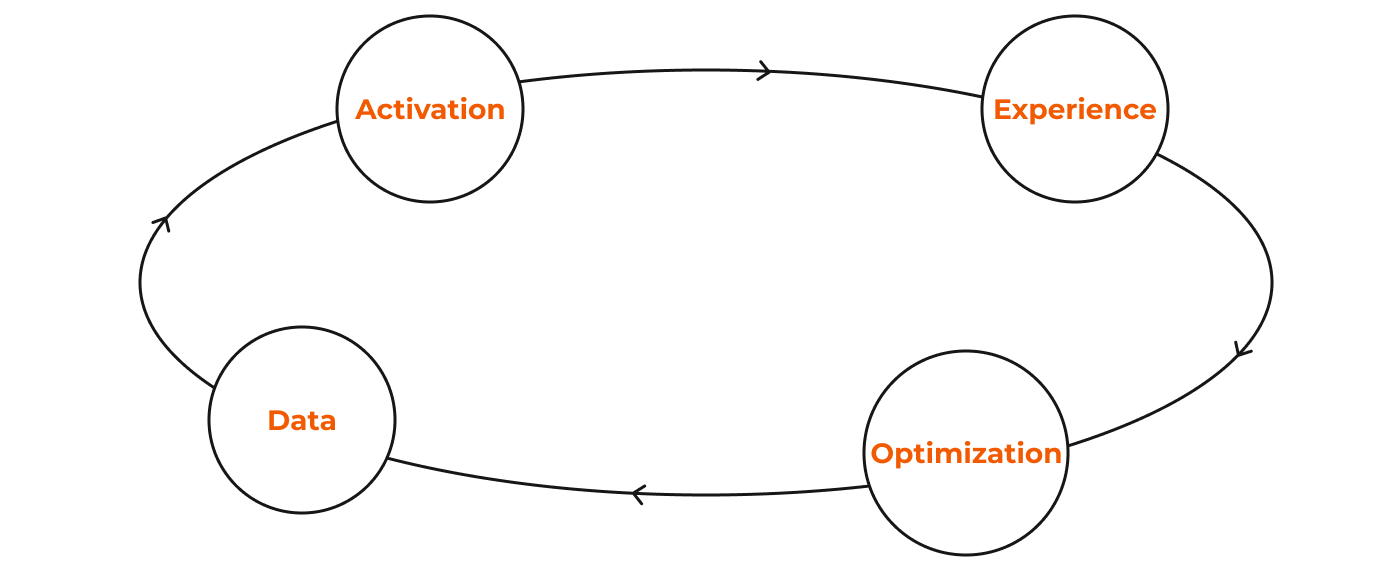Introduction
Digital modernization in large enterprises rarely begins on a blank slate. It starts with complexity, a web of legacy systems, multiple websites, disparate data sources, CRM platforms, ERP platforms, MarTech tools, Subscription Management Systems, Translation Management Systems (TMS), database dumps, digital asset backups, and teams working in silos. Over time, these systems grow, evolve, and collide, creating what many leaders quietly acknowledge: a fragmented digital ecosystem that slows innovation instead of enabling it.
This fragmentation isn’t a failure of strategy; it’s the consequence of survival. As enterprises adapt to market shifts, new tools, and growing customer demands, their digital ecosystems expand organically but without cohesion. What once enabled growth now hinders it. In an era where AI accelerates expectations and agility is non-negotiable, this digital sprawl becomes more than a technical debt; it becomes a strategic liability.
Why Fragmentation Happens
Most enterprises don’t design their digital landscape to be fragmented. It happens incrementally, driven by organizational realities, growth priorities, and well-intentioned decisions made in isolation.
1. Organizational Silos
As enterprises expand, different business units (BUs) operate like independent entities. Each has its own KPIs, budgets, and timelines, and often its own digital strategy. Marketing teams build campaign microsites. Product teams run separate customer portals. Regional divisions deploy localized CMS instances.
The intent is autonomy and speed, but the outcome is duplication and inconsistency.
One enterprise we worked with managed dozens of customer-facing portals, websites, and mobile apps. Their digital ecosystem included a large data lake, multiple data pipelines, and custom-built ERP and CRM systems, all spread across four different CMS platforms. Each team worked independently, with no shared content strategy or unified workflow.
2. Decentralized Tech Decisions
In the absence of a unified governance model, tech stacks often grow organically.
A Business Unit might choose a system that solves its immediate problem, such as a modern DXP or marketing automation platform. Another team may retain legacy tools that “still work.”
Individually, each choice feels rational. Collectively, it leads to:
- Integration challenges
- Duplicated data
- Mounting technical debt
3. Growth And Acquisitions
As business units scale rapidly or enterprises expand through acquisition, digital complexity accelerates. New systems and databases are often absorbed without strategic integration, leading to fragmented architectures. What begins as growth soon manifests as operational friction, fueling silos, duplicating effort, and slowing innovation across the organization.
4. Lack Of Interoperability Standards
Even when teams want to collaborate, inconsistent data structures, APIs, and workflows make integration a complex process. The result:
- Customer journeys break across systems
- Personalization remains limited
- Marketing and IT teams spend more time connecting data than activating it
The outcome is a digital ecosystem where the very systems meant to accelerate innovation end up slowing it down. Users face inconsistent experiences. Teams duplicate effort. And leaders struggle to gain a unified view of performance or customer satisfaction.
How The Framework Came To Life
Earlier this week, Sachin and I were working with a large enterprise facing this exact challenge: a patchwork of digital properties, each optimized locally but disconnected globally. It’s a scenario we often encounter: strong individual systems that, when viewed together, reveal fragmentation and missed opportunities for combined capabilities.
What began as an informal breakfast conversation quickly turned into something more structured. We set out to simplify what digital modernization could look like for organizations operating at this scale. By the end of that morning, we had outlined the early foundation of what would become our Four-Layer Framework, a practical model for aligning complex digital ecosystems.
In the days that followed, we refined the framework in working sessions with leaders from marketing, analytics, data, UX, technology, SEO, IT, and product. What made it click wasn’t just the structure; it was the clarity it brought. Teams across functions could finally see modernization not as a one-off initiative, but as a living system of interdependent layers working in harmony.
The Four Layers of Digital Modernization
This framework comprises four interconnected layers that evolve in a loop rather than a linear progression: Experience, Data, Activation, and Optimization.
1. Experience Layer: Unifying Digital Touchpoints
This layer encompasses all digital touchpoints through which customers interact with the enterprise, including websites, mobile apps, portals, and even physical kiosks connected via digital interfaces. It’s where brand experience, accessibility, and usability converge. Technologies commonly employed here include CMS platforms, decoupled or headless front-end frameworks, mobile applications, digital experience platforms (DXPs), and digital asset management systems (DAMs).
Typically, things go wrong when each product or business unit creates its own website or app without a shared design system or content model. Content gets duplicated, brand consistency weakens, and authoring experiences become cumbersome. Marketers spend more time managing systems than crafting journeys. A strong Experience Layer ensures consistent branding, efficient workflows, and easy integration with underlying data systems.
2. Data Layer: Building The Intelligence Foundation
The Data Layer is where intelligence is gathered, stored, and structured. It brings together first-party, behavioral, transactional, and operational data from CRMs, analytics systems, ERPs, and external integrations into a unified foundation. Technologies such as data lakes, data warehouses, CDPs, ETL pipelines, and analytics platforms typically sit here.
What typically goes wrong here is fragmentation and inaccessibility. Data is often trapped in silos scattered across systems and owned by different teams. Without transparent governance, data definitions and quality vary, resulting in incomplete insights and ineffective personalization efforts. A strong Data Layer focuses on governance, quality, and accessibility to create a single source of truth that can be safely leveraged for analytics, personalization, and AI applications.
3. Activation Layer: Turning Intelligence Into Action
Activation is where insights are applied. It’s the orchestration hub that connects marketing, sales, product, and experience systems to deliver contextual engagement from campaigns and personalization to automation and notifications. Common technologies include marketing automation platforms, personalization engines, CRM integrations, and content recommendation systems.
Common challenges at this layer include disconnected tools, unclear ownership, and an overreliance on manual processes. Marketing teams often face friction when activating data-driven campaigns due to limited integrations or a lack of visibility into performance. The Activation Layer thrives when marketers and business users have self-service access to unified data, enabling seamless and relevant cross-channel engagement for users.
4. Optimization Layer: Continuous Learning And Improvement
Optimization is the layer that closes the loop and, when done right, continuously sharpens the entire digital ecosystem. It leverages analytics, experimentation, and AI to refine performance across content, design, targeting, and experience. This includes tools like A/B testing platforms, advanced SEO and analytics suites, and AI-driven technologies powering approaches such as Answer Engine Optimization (AEO) and Generative Experience Optimization (GEO).
The breakdown often occurs when insights remain siloed, trapped in dashboards, or are acted on inconsistently. Too often, organizations equate measurement with progress but stop short of activating those learnings. True optimization is not reactive; it’s proactive, predictive, and iterative. It feeds intelligence back into strategy, accelerating feedback loops and enabling smarter, faster decision-making across every layer of the digital experience.
The Continuous Feedback Loop
What makes this framework powerful is its circular nature.
Insights generated in the Optimization Layer feed back into Data. Data improves Activation. Activation enhances Experience.
The loop continues building maturity with every iteration.

This shift transforms digital modernization from a one-time program into a continuous capability. Enterprises move from static systems to adaptive ecosystems.
Why This Framework Works
Modernization efforts often stall because they lack structure, shared understanding, or a path to scale. This framework addresses those gaps by providing a practical model for navigating complexity with clarity and cohesion:
- It bridges strategy and execution. The framework creates a shared language for marketing, IT, and leadership to align goals and measure maturity.
- It turns complexity into structure. By breaking modernization into connected layers, enterprises can evolve systematically, rather than attempting an all-at-once overhaul.
- It embeds AI responsibly. Rather than layering AI as an afterthought, the framework ensures AI readiness and learning are built into every layer.
- It strengthens governance and alignment. The governance model evolves alongside the framework, bringing business units and teams together under shared standards, workflows, and accountability, ensuring cohesion without sacrificing agility.
Where Enterprises Can Begin
Modernization doesn't require a revolution; it requires clarity where there’s complexity. Start by mapping your digital ecosystem across the four foundational layers. Understand what you have, where it overlaps, and how it connects.

Then, take a deliberate path forward: unify your architecture, activate your assets, and build a culture of continuous optimization.
The future of digital isn’t defined by how many platforms you launch; it’s shaped by how intelligently they work together. At Axelerant, we don’t just support modernization, we architect it. And we’re ready to help you lead the way.

Prateek Jain, Director, Digital Experience Services
Offline, if he's not spending time with his daughter he's either on the field playing cricket or in a chair with a good book.

 We respect your privacy. Your information is safe.
We respect your privacy. Your information is safe.



Leave us a comment